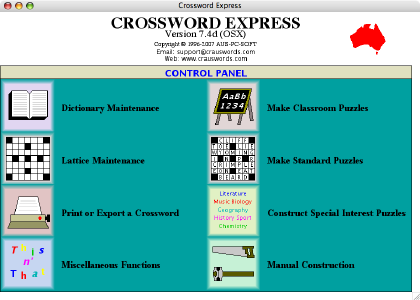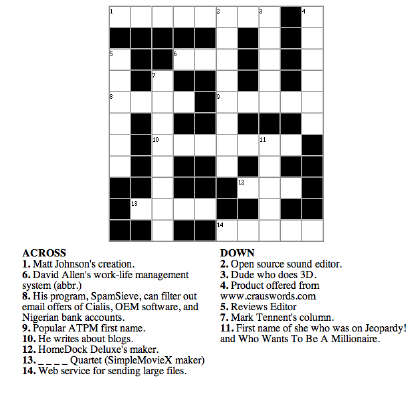Software Review
Crossword Express 7.4d

Developer: AUS-PC-SOFT
Price: $35 (Lite); $140 (Pro)
Requirements: Macintosh (68K, PowerPC, or Intel). Not Universal.
Trial: Feature-limited (only saves and prints 10×10 and smaller puzzles)
Years ago, when I prepared for the Scholastic Achievement Test (SAT), my main focus was the English portion of the test, as English was not my first language. I got the idea of playing crossword puzzles as a fun way to reinforce my study. At one point, I wanted to make them myself, and got nowhere fast. It was mid-1980s, and the personal computer revolution was well under way, but I was just a high school kid and didn’t own a computer. I suppose master makers usually have all the words in their heads, but for others the task of making crossword puzzles is best relegated to computers.
Fast forward to 2007. Through some free local daily newspapers, I had a renewed interest in doing crossword puzzles. Naturally, I wanted to make my own puzzles now that I own a Mac. I wanted to make puzzles just like those I played in the papers, in which the shortest word length is three, the lattice design is symmetrical, and all the words have clues. There are Web tools, such as the Puzzlemaker, but the puzzles made via the Web tools do not meet my expectations. I came across a few Mac programs and settled with Crossword Express (CWE) OS X from AUS-PC-SOFT.
Installation is a matter of moving the uncompressed files, in their own folder, to wherever you normally keep applications. CWE has different Mac versions, going way back to support the Motorola 68K chip. There’s a PowerPC version for OS 9 users and an OS X variant for all OS X versions. No Universal version of CWE is planned at this time. This review was made on a PowerBook G4 running Mac OS X 10.4.
Featurewise, CWE also has different versions. With the $35 Lite version, you can make crossword puzzles and word search puzzles up to a size of 47x47. You also have access to a set of Java applets on the CrausWords Web site to Web-enable the puzzles you made. The Lite license allows you to keep CWE on only one computer at any one time. On the other hand, the $140 Pro version lets you have CWE installed on unlimited number of computers at a physical location. With CWE Pro, you can also make many other types of puzzles, such as sudoku, kakuro, and acrostics. Likewise, with the Java applets available on the CrausWords Web site you can publish all such puzzles on the Web. With both versions, you are entitled to all future upgrades of CWE for free.
Registration is done via PayPal. In my case, I got the necessary info to unlock the demo version of CWE in five hours. I think the people who want to make crossword puzzles are patient, so a wait of a few hours is not a long time.

Crossword Express works mostly from the Control Panel.
The master puzzlemaker can dive straight for the Manual Construction button. Pick an existing lattice and off the master would go. Should he need it, the Suggestion button is readily available in the window. One click on it and he gets a list of words that fit into the current location. If you are an amateur or wannabe maker like me, it’s best to head for the Make Standard Puzzles button. Again, you would select a lattice from the many built-in. Enter a few words and clues, and when stuck simply click the Start Make button. CWE will fly into action, and it draws from the selected dictionary to best fill out the rest of the puzzle for you.
Relying on CWE’s many built-in dictionaries can churn out puzzles quickly, but the puzzles thus made are not really yours. A great portion of the puzzle should be words and clues you made up. This is when you need to click the Dictionary Maintenance. The built-in dictionaries—English, French, German, Spanish-English, etc,—are yours to edit, but the fun begins when you create your own. The idea is that you build your own dictionaries, with your own words and definitions. For example, I am trying to make an ATPM-themed dictionary, using names of software reviewed in ATPM and staff members’ names. One of the words is “Dudar,” and its clue is “Dude who does 3D.”
Be patient and enter many words, say 200 or more, then re-visit Make Standard Puzzles. Even with what you think is a big dictionary, it may not be enough for the selected lattice and you may need to choose a smaller lattice or go back to the dictionary and enter more words. The work of building a dictionary is tedious, but it is a controlled tedium you deal with. I much prefer building a dictionary of a few hundred words then letting CWE use brute force to squeeze my word list into the puzzle. It is much less frustrating than doing the work manually. Making a good crossword puzzle takes time and patience. If you have neither, you are better off playing shoot-em-up games or some gem-switching game.
The creator of CWE correctly surmises that lots of times one custom dictionary just doesn’t cut it. With Make Standard Puzzle, you can use a second dictionary to fill the puzzle, but the second dictionary can be used in only one direction. You can have the second dictionary handle either all the DOWN words or all the ACROSS words, but not both. To use a dictionary to fill in any gaps, DOWN or ACROSS, you need to resort to Construct Special Interest Puzzles. You build Special Interest dictionaries the same way as standard ones, except that you name them with a leading dollar sign ($), e.g $ATPM instead of ATPM. You can choose up to four special interest dictionaries to have words drawn from, then specify a back-fill dictionary. For example, I can have an ATPM-themed dictionary called $ATPM, then a Mac-themed called $Mac, and yet another one for general computing called $Computing. I would then choose the English dictionary as back-fill. I still can manually insert words and clues, perhaps those I want to show up in the puzzle. Click Start Make, and CWE would quickly plow through the special interest dictionaries and the English dictionary to find the best possible match for the selected lattice.
Naturally you should be able to save and print the dictionaries and puzzles that you create. CWE offers many printing options. You can print everything—puzzle, clues, and even the previous puzzle’s solution, just like your typical newspaper’s puzzle. You can also print just the puzzle or just the solution. Dictionaries and puzzles can be saved only in the same folder where CWE is stored. This arrangement can be a problem if you share your Mac with someone who has restricted access. In such cases, you may need to re-permission the CWE folder in order to allow the restricted user the right to create his own dictionaries and puzzles.
In this day and age, most programs need some degree of interaction with the Web. With CWE, there are a number of ways to publish the puzzles on the Web, with varying level of user-friendliness. The simplest option is to export puzzle and clues to the clipboard. A picture thus produced can be easily shared, either in a blog or even in Flickr. The next option is to export the puzzle and clues as an HTML file, but it takes a little more work. Because CWE relies on having a GIF file called black.gif in the same folder with the puzzle, the HTML version looks all wrong when black.gif is not present, such as when you export the HTML file to somewhere other than CWE’s folder. To put the HTML puzzle on the Web requires the upload of the file black.gif. This requirement rules out the use of the HTML version on blog sites like Blogger, where you have little control over graphic elements unless you know some intermediate HTML coding. Surely you can update the HTML code to fetch black.gif from somewhere else on the Web, but again the average user wouldn’t know enough HTML programming to carry out the extra work. See the two classroom puzzles below to see the difference the presence or absence of black.gif makes.

Without black.gif

With black.gif
Lastly, for the serious coders, there’s the CWE Java applets. You are supposed to upload to your Web server the file cweapplet.class, the puzzles with the .cwe extension, and the sample HTML file(s) edited to refer to your carefully crafted puzzles. While the applets are very powerful and allow for plenty of customization of the puzzle, making use of them does require a degree of programming skill. One misspelled word and the applet just won’t work, such is the way when you write codes by hand.
I believe neither the HTML export option nor the Java applet appeals to the average CWE user. CWE would have a much better Web integration if it included the option to publish to .Mac or iWeb. Better integration with iLife would be beneficial, too. Supposedly there’s a way to include a picture as the background for CWE puzzles, but I haven’t figured it out yet (if only CWE could read iPhoto’s database and offer a simple way to pull in the pictures…).
Based on the fact that CWE’s built-in dictionaries’ filenames are limited to eight characters or fewer, I assume that CWE started out as a Windows application. As a matter of fact, there is a version of CWE for Windows, and the puzzle files created by either the Mac or Windows version can be used on either platform. While I am grateful that the Mac platform has a powerful crossword maker in CWE, using it is a very un-Mac-like experience. On top of the lack of integration with .Mac and iLife, the Control Panel looks very unattractive. The pictures have no shadows, are not anti-aliased, and are flat.
With the ability to generate many kinds of crosswords, plus many other kinds of puzzles with the Pro version, many built-in or downloadable dictionaries, the use of customized dictionaries with built-in ones, CWE is a very powerful puzzle maker. However, given its extra requirements to publish puzzles on the Web and the lack of any Mac integration, I can only give it a Good rating.
Reader Comments (1)
I have done a lot of work with the program on my G4, and was just about to try the updated version which facilitates the creation of the interactive puzzles, when half of my G4's memory died. It's up again, but I sure would prefer using it on my newer computers.
Add A Comment